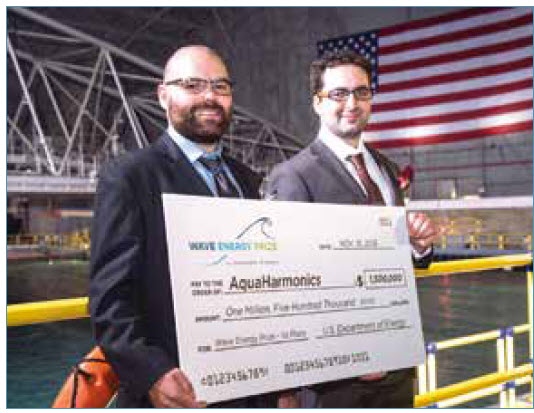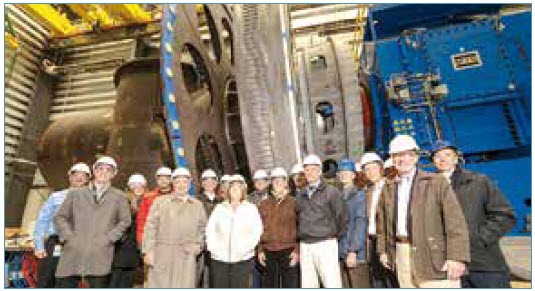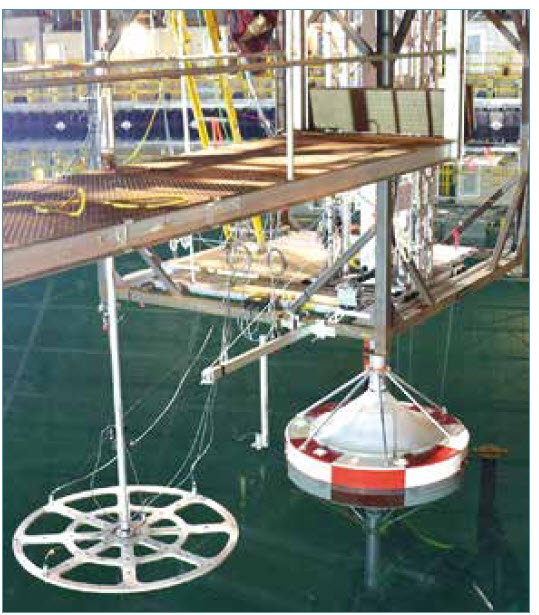UNITED STATES OF AMERICA
RESEARCH & DEVELOPMENT
NATIONAL LABORATORIES
The DOE’s national laboratories possess unique instruments and facilities capable of addressing large-scale, complex R&D challenges with research expertise and an approach emphasizing translating basic science to innovation. The Program partners with several of these important institutions to support R&D in MHK technologies.
Sandia National Laboratories (SNL): Through partnerships with several national laboratories and academic institutions, SNL is leading efforts in technology development, market acceleration, and reference model developments. SNL contributes to MHK technology in the following areas:
- Advanced non-linear controls, system identification and wave tank testing, open source code development, device and array optimization, and operational and extreme events simulation
- Design, analysis, and testing of hydrokinetic turbines; including application of novel measurement techniques (e.g., fiber Bragg grating (FBG) sensors for high-fidelity load measurements)
- Advanced materials development, such as novel coatings and composites
- Ocean wave modeling, resource assessment and characterization, and classification
- Measurement and modelling of tidal and river current flows
- Wave and tidal energy modelling to predict environmental effects of energy removal and inform optimal device spacing
- Modelling tools for MHK environmental impacts, such as mammal strike impact and acoustic generation and propagation
National Renewable Energy Laboratory (NREL): NREL’s water power program leverages 35 years of experience developing renewable energy systems to research, evaluate, validate, optimize, and demonstrate innovative water power technologies. NREL conducts and supports research and development on MHK technologies in a wide range of areas, including:
- Design and Simulation—Application of renewable energy system experience to MHK technology development and open-source tool development
- Technology Validation and Optimization—Assessment of MHK systems and components performance and reliability in lab and open-water environments
- Resource Characterization and Maps—Measurement systems and simulation and visualization tools that accelerate MHK engineering and project development nergy and Market Analysis—Cost models and tools to evaluate the economic potential and impacts of MHK technologies and projects
- Grid Integration—Assess impacts and value of MHK generation on power systems, from small distribution systems to high-penetration interconnection
Pacific Northwest National Laboratory (PNNL): PNNL supports the Program through research, engineering, information aggregation and dissemination, resource assessment, characterization, and forecasting. The laboratory also participates in market analysis, planning, and coordination to overcome barriers for water power. PNNL operates the only facility dedicated to coastal sciences in the national laboratory system. Its unique Marine Sciences Laboratory is located on the Olympic Peninsula in Washington. PNNL’s specific efforts include:
- MHK environmental impacts research, international outreach, engagement, collaboration, and information sharing
- Tidal and current model development and validation
- MHK technology advancement through advanced materials and manufacturing reliability
- Wave resource assessment and characterization
- Monitoring tools, mitigation technologies, and methodologies
- Education outreach and information sharing
- Implement Annex IV under OES on behalf of the Program
Oak Ridge National Laboratory (ORNL): ORNL conducts research in support of the MHK Program’s mission, including:
- Assessing the environmental effects of instream technology
- Advanced materials
- Manufacturing for cost reduction and design flexibility in water power technology
- Assessment of stream resources amenable to low-cost, low-impact development
R&D HIGHLIGHTS
In 2016, the Program supported a variety of activities to enable technology breakthroughs that “float all boats,” benefitting numerous industry participants or having broad public benefits. Among its activities, the office supported initial device demonstrations to prove efficiency, reliability, and commercial viability and developed strategic partnerships to leverage and focus resources (i.e. military, international organizations, private industry). R&D activity generally falls into one of four categories: technology maturity, deployment barriers, market development, and cross-cutting approaches.
Below are select R&D highlights from each category that occurred in 2016:
|
TECHNOLOGY MATURITY Teams worked toward the ambitious yet achievable goal of doubling the efficiency of WEC devices over the stateof-the-art technology prior to the launch of the prize. CalWave Power Technologies and Waveswing America were awarded second and third place, respectively, with $500,000 and $250,000 in cash prizes. |
 |
The Wave Energy Prize was a catalyst for a technology leap, and the innovations accrued during the competition will drive down the cost of wave energy and help the sector achieve commercialization faster. Multiple technical innovations in the areas of controls, geometry, and survival strategies have resulted from the Prize. Some examples include adaptive sea state-to-sea state control; wave-to-wave control; power absorption in multiple degrees of freedom; optimized float shapes for energy absorption from a broad bandwidth of wave frequencies; survival strategies, such as submerging beneath the surface during extreme storms. But it’s important to note that all the benefits of the Wave Energy Prize have yet to be realized. The technical advances made during this Prize competition will help developers accelerate the iterative learning process they face on the path toward commercialization. It is also the Program’s hope that communities formed among investors, marine energy and engineering experts, and onlookers will accelerate the technical and financial capacity of developers. In addition, data from Prize testing will become publically accessible in November 2017—letting current and future technology developers benefit from the data collected in the Prize.
MHK Generator Technology Testing: In 2013, three entities were awarded $8 million to develop and demonstrate next-generation Power Take-Off (PTO) systems for MHK applications under the System Performance Advancement effort. In 2016, ABB, Inc., successfully built and tested one of the world’s largest magnetically geared generators for direct-drive applications. The generator has been designed for low-speed, high-torque operation and provides increased reliability, overload operation and protection, controllability for peak power, and torque limiting. ABB partnered with Resolute Marine Energy to support the design and integration of the next generation PTO into Resolute’s oscillating wave surge converter system.
|
Columbia Power Technologies, Inc., (CPwr) has completed design and fabrication of a novel, commercial-scale, direct-drive generator with a novel air gap control system for wave energy converter devices. The PTO employs modular permanent magnet generator components with advanced power electronics to simplify transportability, operations and maintenance, and improve energy capture and reliability. These attributes are enabled by the following innovations:
|
 |
- The ability to reduce the StingRAY’s cost-of-energy by increasing generator diameter to much larger dimensions, while maintaining a small air gap
The PTO project aims to validate defined performance targets for this critical technology element. A successful demonstration of the 6.5m diameter permanent-magnet generator is expected to confirm the ability to further reduce cost of energy through air-gap reduction to 2mm or less on future systems. CPwr has commenced dry testing of the commercial- scale PTO on the 5-MW dynamometer at NREL’s National Wind Technology Center (NWTC), leveraging decades of wind industry research and development experience, and will be completed in early 2017.
Ocean Renewable Power Company (ORPC) has completed trade studies for submersible generator designs and novel bearing concepts for integration with MHK systems. Generator trade studies have evaluated switched reluctance generator concepts against permanent magnet designs, and bearings development has focused on significantly reducing losses from driveline friction in tidal applications. ORPC has employed Rolls Royce Marine to fabricate a permanent magnet generator that allows for modular integration of ORPC’s bearing concept. Testing will be completed in 2017 on a section of the TidGen® driveline to demonstrate PTO performance improvements.
|
Advanced Design Tools: In 2016, the Program and national laboratories performed research with the objective of improving performance, reliability, and survivability, while lowering the cost of energy. NREL and SNL worked on the following projects in 2016 to provide open-source simulation tools, develop extreme condition design methodologies, and advance control strategies:
|
 |
- SNL and NREL worked to advance WEC control strategies through two projects:
- SNL completed extensive wave tank testing using advanced system identification methodologies. The models developed from this work will serve to improve the performance of future control strategies. Data from the wave tank testing is available on the MHK Data Repository (https://mhkdr.openei.org/).
- NREL explored the feasibility of using advanced control strategies in conjunction with “active geometry” WECs that have the ability to change their geometry with changing wave conditions.
NNMREC’s Advanced Laboratory and Field Arrays Project (ALFA): NNMREC is a multi-institution entity with a diverse funding base focused on R&D for marine renewables. The ALFA project conducted by NNMREC works to reduce the LCOE of MHK energy by leveraging research, development, and testing capabilities at Oregon State University, University of Washington, and the University of Alaska, Fairbanks. ALFA will accelerate the development of next-generation arrays of WEC and tidal energy conversion devices through a suite of lab- and field-focused R&D activities spanning a three-year performance period. These tasks include:
- Debris modelling, detection, and mitigation
- Autonomous monitoring and intervention
- Resource assessment and characterization for extreme conditions
- Robust models for design of offshore anchoring and mooring systems
- Performance enhancement for marine energy converter arrays
- Sampling technique evaluations for MHK biological monitoring
NNMREC’s ALFA project is also developing a low cost semi-autonomous underwater vehicle (AUV) to assist with maintenance of MHK devices. The AUV will be capable of performing inspection, monitoring, and intervention, and it will have a lower cost than existing remotely operated underwater vehicles. In 2016, the second year of the ALFA project, NNMREC demonstrated the navigation station-keeping capabilities of the AUV in several ocean trials with low errors in mean position and heading (direction). In the third year of the ALFA project, autonomous mapping and intervention operations will be tested.
Metrics development: Well-developed, universal economic performance metrics let investors more confidently focus on promising technologies. The predominant metric for energy technologies at commercial scale is the levelized cost of energy (LCOE). But because LCOE estimation for devices at low technology readiness level (TRL) is prone to high uncertainties, it is important to identify other techno-economic performance metrics that are more suitable for the early stages of technology development. As such, technology performance levels (TPLs) have been introduced and refined as a techno-economic performance assessment metric for WEC technologies. Even at low TRLs, the TPL assessment is effective as it considers a wide range of WEC attributes that define the techno-economic performance potential when developed to higher TRL, and it highlights potential showstoppers at the earliest possible stage of WEC technology development. The TPL assessment methodology was revised in 2016 through a consistent application of the systems engineering approach. This approach led to the identification of a full set of stakeholder requirements and necessary WEC functions. The stakeholder requirements directly led to the assessment criteria for the updated TPL metric. For more information, visit http://go.usa.gov/x9MYg.
DEPLOYMENT BARRIERS
Environmental R&D: In 2016, the Program awarded seven new projects a total of $5.49 million to improve the technical performance and reduce costs associated with existing environmental monitoring technologies for use around MHK devices. These technologies are focused on monitoring marine organism interactions, noise produced by MHK devices, electromagnetic fields produced by subsea cables and MHK devices, benthic habitat monitoring and mapping, and the refinement of integrated instrumentation packages to monitor MHK devices more effectively.
Also in 2016, a number of existing projects made excellent progress. Five projects to develop new environmental monitoring technologies focused on the detection and classification of marine animals in the vicinity of MHK devices, mea surement of noise produced by devices, automation of optical data processing, and the development of integrated instrumentation packages. Many projects performed prototype tests in tank settings and extended field trials, demonstrating the technical capabilities of the monitoring instruments. The Program had awarded $2.75 million in 2014 to support these projects.
Nine projects that focused on advancing the understanding of potential environmental effects from the deployment and operation of MHK devices either completely finished or are in the process of finishing. The projects included researching device-generated noise and its subsequent effects on marine megafauna, understanding interactions between fish and tidal turbines, developing and using models to predict strike occurrence, and assessing the potential effects electromagnetic fields may have on marine species. The Program awarded $2.4 million in 2013 to support these projects. The final reports from these projects will be made publically available on the Tethys database (https://tethys.pnnl.gov) once they are complete.
MARKET DEVELOPMENT
Market Analysis Efforts: In 2017, the Program will research the viability of non-utility scale electricity generation end uses and alternative markets or value streams, such as reverse osmosis desalinization for coastal urban water supply, micro-grids, forward operating military applications, remote islands, ocean and weather observation systems, shoreline protection and resilience applications, aquaculture, and data centers. This new effort builds off FY16 research into WEC-powered RO desalinization systems, which has yielded important metrics to focus future R&D activities, developed computational modules for design simulation, and produced an initial techno-economic assessment to understand market potential. By assessing early adopter markets of high value for MHK, their unique scale, and synergies with utility-scale generation, the Program’s 2017 market study will identify the most competitive cost-of-energy markets for MHK. By the end of the year, a report will be developed outlining the most salient non-electric and off-grid electric market opportunities, the estimated market sizes, and the practicality of deploying existing technologies.
CROSS-CUTTING APPROACHES
Resource Model Refinement and Wave Classification: In 2016, the Program identified and published a list of locations where tidal and wave resources match electricity loads, as well as where local economics would be conducive to marine power. With that intelligence, the Program modelled wave and tidal regional sites along U.S. coasts. A wave classification scheme is also being developed using this information. The scheme uses peer-reviewed information to identify which variables are most important in making classifications. Throughout 2017, the Program will collect data from various wave and tidal sites to verify and validate models, modelling efforts, and the wave classification scheme, as well as adjust it when necessary. Feedback from the Marine Energy Council concerning tidal assessments have been heeded, and funding has been allocated to review the Program’s analysis. In addition, other modelling efforts continue with high resolution grids for wave and tidal areas of interest, which will be added to the MHK Atlas (https://maps.nrel.gov/mhk-atlas/).
MHK Data Repository (MHKDR): Working with NREL, the Program launched the MHKDR website in March 2015. The repository houses all data collected using Program funds and serves as a data-sharing platform to help store and disseminate open-source data relevant to the design and development of marine energy technologies. Since then, 10 content models have been developed to help structure the data submitted to the MHKDDR, and more than 100 submissions from DOE-sponsored projects have been uploaded. The project data (subject to moratorium) is now accessible to the public and indexed on national search engines, such as Data.gov, resulting in thousands of downloads from users across the world. Transparency and open data are important to accelerate technology development and to avoid funding the same technology evolution by several different companies. It also helps to attract new players from related offshore and engineering sectors. The MHKDR provides an easy method for uploading data in a secure environment to help with the reporting requirements of national labs and industry awardees. Awardees who received U.S. public funding through financial assistance mechanisms are able to keep their data proprietary up to five years, after which it is to be made available to the public.



